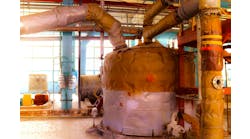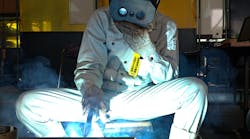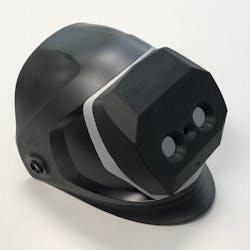SRI International (SRI), a nonprofit research center, announced their collaboration with Kawada Technologies, Inc. (KTI) and Kawada Industries to develop Xtreme Dynamic Range (XDR) weld visualization technology that uses image processing to safely visualize live weld details to the welder. XDR has been further applied to a next-generation, 3D-welding helmet that uses cameras to completely transform the world of welding.
XDR Weld Visualization Technology
For this project, the objective was to enable a larger number of welders and improve their welding quality by greatly enhancing the visibility of the welding scene, including the welding tip, welds and surrounding welding scene using ordinary image sensors rather than special high-cost image sensors. Specifically, the newly developed technique manages shutter speed and the time at which images are captured with microsecond resolutions to acquire images to perform real-time XDR Fusion. These captured frames with different exposure conditions are image-processed by a wearable battery-operated GPU to synthesize the frames in real-time into one 3D stereo vision stream for visualization within the helmet. As a result, instead of the limited commercial camera dynamic ranges of 60 to 70 dB, the dynamic range of the visualized scene using commercial cameras in the XDR welding helmet, is expanded up to 150 dB without the need for special image sensors. In addition, using commercially available devices allows the welding helmet to benefit from high volume costing and proven component reliabilities.
Next-Generation, 3D-Welding Helmet
The next-generation, 3D-welding helmet equipped with XDR acquires and synthesizes images as a stereo camera unit. These images are displayed, with minimal delay, inside the helmet on a head-mounted display (HMD) as a stereo image. This helmet system runs on wearable hot-swappable batteries and therefore can be used indefinitely in environments that have no external power source. A welder wearing the next-generation, 3D-welding helmet will be able to weld more reliably due to the ability to view weld beads, the welded items, and the working environment, which are collectively difficult to see using traditional welding helmets. The helmet also includes display and recording functions of various real-time welding status parameters related to welding (temperature, voltage, current, etc.). This allows welders to easily collect and check useful information to ensure a high-quality weld, which in turn accelerates the learning curve. Finally, the welder's eyes are completely protected from arcs because the weld is viewed indirectly through the screen in the helmet.
SRI International, a research center headquartered in Menlo Park, California, creates world-changing solutions to make people safer, healthier and more productive. Kawada Industries' unique techniques for manufacturing thick steel plates have led to much success in the construction and bridge engineering industries. KTI Kawada Group began this project with the goal of passing on these core techniques of their tradecraft in an effective and sustainable manner. With the cooperation of SRI, KTI Kawada Group developed XDR, which enables one to shorten the time required to train new welding technicians while continuing to pass down welding knowledge in an effective manner. KTI Kawada Group is also working on analyzing data obtained by the helmet to perform various tests for improving the quality and reliability of welding. "Kawada came to SRI with a need to greatly shorten the time required to train new welding technicians while continuing to pass down welding knowledge in an effective manner to new welders,” said Mike Piacentino, Senior Technical Director of Vision Systems for SRI International. “The real-time weld-visualization technology developed by SRI provides a higher dynamic range to allow humans and robotic welders to see more than just the welding tip. The ability to view real-time welds maintains quality and informs the welder of low quality or possibly failing welds, which is a critical advantage over conventional welding where precision welds are critical to structural integrity and public safety of infrastructures such as construction and bridge engineering.” The next-generation, 3D-welding helmet will be improved over the next year and will be utilized to teach technical welding skills at Kawada Industries. The KTI Kawada group is expected to gain insights that can be applied to support new technologies and product developments. "Welding is the most important and difficult skill to transfer from skilled welders to novice welders,” said Noriyuki Kanehira, Project Leader and Director, Kawada Technology Research Center. “Visualization is the key. In conventional welding, the operator can see only the tiny bright area of the arc and everything else is darkened by the thick shading filter attached to a welding helmet. This new technology developed by SRI clearly visualizes the entire area of the workspace with appropriate brightness and contrast. Welding visualization directly leads to stabilizing welding quality and providing traceability.”











